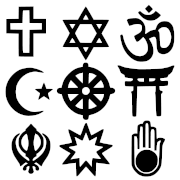
It is no secret that in Islam it is denied that Jesus is God's Son. But if He is not the Son of Allah, then who's Son is He according to the Quran?
Of course we know the Judeo-Christian Bible teaches that Jesus is the Son of God:
Whosoever shall confess that Jesus is the Son of God, God dwelleth in him, and he in God.- 1Jn 4.15.
Neither is this a doctrine introduced in the New Testament Scriptures. Though Judaism does not teach that Jesus Christ is God's Son, the doctrine is nonetheless found in the Jewish Scriptures called the Tanakh, what Christians refer to as the Old Testament:
I will declare the decree: the LORD hath said unto me, Thou art my Son; this day have I begotten thee.- Psa 2.7;
and, Kiss the Son, lest he be angry, and ye perish from the way, when his wrath is kindled but a little. Blessed are all they that put their trust in him.-v.12.
Thus it is not inconceivable that the earliest Christians, who were Jewish believers in Jesus as the promised Messiah, would also believe that He was the Son of God.
What does the Quran teach on this matter?
Say: He is Allah, the One and Only; Allah, the Eternal, Absolute; He begetteth not, nor is He begotten; And there is none like unto Him.- Q 112:1-4.
And, The Jews call Uzayr [Ezra] a son of God, and the Christians call Christ the Son of God. That is a saying from their mouth; (in this) they but imitate what the unbelievers of old used to say. Allah's curse be on them: how they are deluded away from the Truth!- Q 9:30.
And, To Him is due the primal origin of the heavens and the earth: how can He have a son when He hath no consort?- Q 6:101a.
Islam rejects the notion that God is "father", or can have a son because it implies in the Arabic mind either the idea of procreation, or temporal sequence. For one, the Moslems have an aversion to these ideas because the pagan Arabs of Mecca in pre-Islamic times worshiped whom they said were daughters of Allah: their names are even given in the Quran as Al-Lat, Al-Uzza, and Manat (Q 53:19-20). These goddesses with Allah (Il-Lah- the god) were the head of the Arabic pantheon whose center of worship was at Mecca.
Now Moslems believed that Mohamed sought to return people to the true monotheistic religion of ancient times. Etymologically this is true. And Mohamed in this regards was the ultimate iconoclast amongst his people. I will at this time give no weight to supposed evidence of archeology from Robert Morey as inconclusive, as he claims that Allah was a moon god worshiped in pre-islamic times. Etymological evidence suggests otherwise.
In all fairness and misconceptions aside, the Quranic narrative is correct in this regard. And we can understand as Christians why Islam, and the Quran in particular are opposed to the idea of God having a Son, or being a Father. Because in the Arabic culture there had to be a strong exodus from the idolatry and polytheism of Mohamed's day in which Allah was included. Even in Israel in ancient times the worship of Yahweh (Elohim) was mixed with that of other gods, and had to be reclaimed in its original monotheism by an arising prophet (Ezek 14.1-7; Zeph 1.4-5).
Before we answer the question, Who's Son is Christ according to the Quran, we will first answer the Islamic objection to the Father and Son of the Godhead.
First, it is a misconception on Islam's part to assume that the doctrine of God the Father, and God the Son are in any way akin to the concepts of the pagan nations among whom Christianity evangelized. We may now appreciate the fervor behind the backlash against idolatry and polytheism as Mohamed sought to distance his people from the idea of Allah having daughters, etc. But it is not in this sense that God is the Father of Jesus Christ:
1) Not in the sense of procreation. God did not come down as Zeus did, and impregnate a woman, and have offspring in this way.
No. But God in His Ultimate Unity is infinitely transcendent and unknowable beyond all duality (Dt 6.4; Ga 3.20; Acts 17.23). When He revealed Himself, it was as Father, Son, and Holy Spirit. This revelation is through the Logos, Who is the Second Person of the Trinity, the Son. He who reveals is the Father, and He who is revealed is the Son, in Whom all deity and the cosmos, albeit in its preexistent state (Col 1.15-17; Heb 1.2-3), are known. This is the meaning of this text taken to a metaphysical/theological application: All things are delivered unto me of my Father: and no man knoweth the Son, but the Father; neither knoweth any man the Father, save the Son, and he to whomsoever the Son will reveal him.- Mt 11.27. Therefore, not as an act of procreation with a consort, nor even yet exclusive to the incarnation through Mary (Ps 2.7; Heb 13.8), but as an eternal act of Self-Revelation, the Son is ever revealing the Father in His being revealed as the Logos, and the Father is ever revealing the Son in His being the Revealer, yet they with the divine Breath of Spirit are One in Essence.
2) Not in the sense of temporal sequence, as the texts referred to above (Ps 2.7; Heb 13.8) speak to the eternality of the Self-Revelation of deity. Beyond which God could not be known, nor could He have brought about creation with out introducing duality to Himself in relation to the Cosmos. Thus it was through His Self-Revelation that He could be known, and the Cosmos through Him. Though Essentially He remains One. Nor could we have known such an impersonal God if He forever remained hidden in His transcendent Oneness.
Now on to the question at hand: Whose Son is Jesus according to the Quran? To be sure, He is often called the Son of Mary (Q 19:34). But who was His Father in the Quran? Are we to assume that He was fatherless? God forbid.
No, but we read in the Quran, Behold! the angels said: "O Mary! Allah giveth thee glad tidings of a Word from Him: his name will be Christ Jesus. The son of Mary, held in honour in this world and the Hereafter and of (the company of) those nearest to Allah...She said: "O my Lord! How shall I have a son when no man hath touched me?" He said: "Even so: Allah createth what He willeth: when He hath decreed a Plan, He but saith to it, 'Be', and it is!"- Q 3:45, 47.
And in this same context concerning Mary and her Son Jesus, the Quran again says, It is not befitting to (the majesty of) Allah that He should beget a son. Glory be to Him! When He determines a matter., He only says to it, "Be", and it is.- Q 19:35.
I am not claiming that Islam teaches that Christ is not created, but in the texts above it doesn't seem to say this. What is does say is that a Plan, in this case, the Plan of the Messiah, is created.
Also, Christ is here called a word from Him, that is from Allah. And further, the Quran states, Christ Jesus the son of Mary was (no more than) a Messenger of Allah, and His Word, which He bestowed on Mary, and a Spirit proceeding from Him- Q 4:171a. Though the text here denies the Sonship of Christ, and the very Trinity, nonetheless the language echoes (if not originates from) the gospel of John, In the beginning was the Word, and the Word was with God, and the Word was God. The same was in the beginning with God...And the Word was made flesh and dwelt among us- Jn 1.1-2, 14a.
The Quran, while denying that Jesus is God's Son, nevertheless does not attribute His being sired to human paternity. But the teaching is that Christ was, yes a Word, but also His Word, that is, a Word from Allah.
Is this "word" created? Is this breath from Allah created? If this is believed in Islam, then herein is a big difference, obviously. But conclusively, is He the Son of Mary? Yes. A Son of Allah? This is denied. Yet He has no human father. Instead it is affirmed that He is a word, yea, Allah's very word: to this the Christian Scriptures agree. But it is hinted at, at least, in the Quran that this word, or the Son of Mary was created, as a thing to whom Allah said, 'Be!', and it was. But I would counter this to say that He, as Allah's Word, is the very word 'Be!' And when He, the Logos is spoken to anything Allah wishes, it is.






